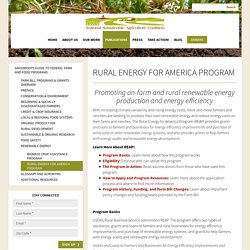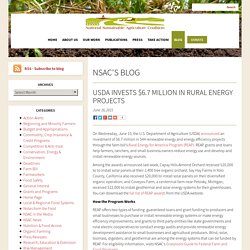

Cheap Solar Comes to Wisconsin. In a sandy field outside Eau Claire, in western Wisconsin, a new crop is sprouting: solar power.

The Eau Claire Energy Co-Op, a member-owned rural co-op with 11,000 customers, is installing the largest utility-owned solar power system in the state, with 2,816 panels capable of delivering 875 kilowatts of DC power. The first section of the system, built by Able Energy of River Falls, Wisconsin, was energized on October 1. The co-op’s Member Solar program offers shares of the system to member-customers at cost -- only $650 per panel, or $2.10 per watt.
The power output from the panels is subtracted from customers’ bills through a virtual net metering arrangement, as if it were produced behind the customer’s meter. Co-op power rates are 12.5 cents per kilowatt-hour in the summer, falling to 10.8 cents in winter. Better Batteries Through Mushroom Technology. Mushrooms never cease to amaze.

They’re one of the weirdest organisms on the planet, and we keep coming up with unexpected uses for them. Actually, some people think mushrooms aren’t from this planet at all. Really. Now comes word that researchers at Researchers at the University of California, Riverside Bourns College of Engineering have found yet another use for mushrooms — in batteries. Energy co-ops: why the UK has nothing on Germany and Denmark. On paper, the Sretton Sugwas solar project just outside Hereford looks a dead cert.

Pitched as the UK’s first community-owned photovoltaic installation on a former landfill site, the project promises to provide clean electricity for 250 homes as well as local jobs and financial returns for residents. But getting small-scale community energy projects off the ground has never been easy. Following a raft of policy revisions over recent months, it just got a lot harder. Dave Prescott, director of New Leaf Solar, the not-for-profit co-operative behind the £1m landfill initiative, is trying to stay positive.
“It’s almost brilliant,” he says in reference to the community energy sector. Policy threats That looks unlikely. As with many in the small-scale green energy industry, Prescott concedes that subsidies must come down over time, especially as the cost of renewable technologies reduces. Consider Brixton Energy, for example. Proven models in Europe Council leadership. By 2100, Earth Will Have an Entirely Different Ocean. The Pacific Ocean.

Image: NASA The ocean is in the midst of a radical, manmade change. It can seem kind of crazy that one of the most immense properties on Earth—the ocean washes over 71 percent of the planet—could be completely transformed by a swarm of comparatively tiny, fleshy mammals. But humans are indeed remaking the ocean, in almost every conceivable way. The ocean we know today—that billions of people swim, fish, float, and surf in—that vast planetary body of water will be of an entirely different character by the end of the century. Two Indigenous Solar Engineers Changed Their Village in Chile. Liliana Terán, left, and her cousin Luisa, members of the Atacameño indigenous people, are grassroots solar engineers trained at the Barefoot College in northwest India.

By installing solar panels in their northern Chilean village, Caspana, they have changed their own lives and those of their fellow villagers. (Photo: Marianela Jarroud/IPS) Liliana and Luisa Terán, two indigenous women from northern Chile who travelled to India for training in installing solar panels, have not only changed their own future but that of Caspana, their remote village nestled in a stunning valley in the Atacama desert. "It was hard for people to accept what we learned in India," Liliana Terán told IPS. "At first they rejected it, because we're women. Her cousin, Luisa, said that before they travelled to Asia, there were more than 200 people interested in solar energy in the village. Cardinal-Hickory-Creek Information & Review Process. Solar energy online classes. Kenyan student converts school's poop into safe, clean fuel. In early January 2013, Kenya’s oldest English-language school, the Maseno School, opened new dormitories for 720 students, and it had a couple of problems.

Pit latrines and a faulty sewage system inevitably left foul odors and polluted local freshwater sources, while the kitchen used firewood for cooking fuel—unhealthy for cooks and the environment alike. High school senior, Leroy Mwasaru, now 17, and four of his friends had an idea: to harvest poop and other waste and turn it into a safe, clean and eco-friendly source of cooking fuel. Check out this video courtesy of Makeshift, and read on past the jump to learn more about the project! Revolutionary new solar windows can generate 50 times more energy than conventional photovoltaics. Rural Energy for America Program. With increasing climate variability and rising energy costs, more and more farmers and ranchers are seeking to produce their own renewable energy and reduce energy costs on their farms and ranches.

The Rural Energy for America Program (REAP) provides grants and loans to farmers and businesses for energy efficiency improvements and purchase of wind, solar or other renewable energy systems, and also provides grants to help farmers with energy audits and renewable energy development. Learn More About REAP! Program Basics: Learn more about how this program worksEligibility: Find out who can utilize this programThe Program in Action: Read success stories from those who have used this programHow to Apply and Program Resources: Learn more about the application process and where to find more informationProgram History, Funding, and Farm Bill Changes: Learn about important policy changes and funding levels provided by the Farm Bill Program Basics.
USDA Invests $6.7 Million in Rural Energy Projects. June 16, 2015 On Wednesday, June 10, the U.S.

Department of Agriculture (USDA) announced an investment of $6.7 million in 544 renewable energy and energy efficiency projects through the farm bill’s Rural Energy for America Program (REAP). Japanese Scientists Transmit Electricity Wirelessly Through the Air. Could Hemp Batteries be a Reality? « Great Things from Small Things .. Nanotechnology Innovation. Researchers have found a way to boost the energy density of supercapacitors through the use of more sophisticated electrodes.

These electrodes are composed of hemp fibers, and they have a high energy storage capacity. The development breakthrough has been made by a Canadian start-up company, led by Dr. David Mitlin. Heating Your Glasshouse. Absolutely FREE videos by Geoff Lawton, World Renowned Permaculture Teacher, Designer and Consultant.

Geoff Lawton visits an enormous community glasshouse located in the cold mountains of Canada to find out how they managed to heat their system over winter without costly power bills. Its an amazing system where the summer heat is pumped and stored below ground and slow released over winter. A fully transparent solar cell that could make every window and screen a power source. Researchers at Michigan State University have created a fully transparent solar concentrator, which could turn any window or sheet of glass (like your smartphone’s screen) into a photovoltaic solar cell. Unlike other “transparent” solar cells that we’ve reported on in the past, this one really is transparent, as you can see in the photos throughout this story.
According to Richard Lunt, who led the research, the team are confident that the transparent solar panels can be efficiently deployed in a wide range of settings, from “tall buildings with lots of windows or any kind of mobile device that demands high aesthetic quality like a phone or e-reader.” Scientifically, a transparent solar panel is something of an oxymoron. Solar cells, specifically the photovoltaic kind, make energy by absorbing photons (sunlight) and converting them into electrons (electricity). To get around this limitation, the Michigan State researchers use a slightly different technique for gathering sunlight. 5 Companies Making Fuel From Algae Now. Its time to ditch the grid book. 17-Year-Old Builds Algae Biofuel Lab in Her Bedroom to Win $100K Intel Science Talent Search Prize. Meet a next-generation scientist making the next generation of biofuel. 17-year-old Sara Volz invented a process that increases the amount of biofuel produced by algae to win this year’s Intel Science Talent Search.
The Colorado Springs student claimed the $100,000 grand prize with her project, which uses artificial selection to pinpoint which organisms are churning out the most fuel. This new method not only helps to bring down the overall cost of algae biofuel, but it was developed primarily in her bedroom under a lofted bed! As dedicated a scientist as her adult colleagues, Sara Volz took to sleeping with the same light cycles that her algae required to grow. BIOENERGY Training Center UW Cooperative Extension.
Solar Training - Women's Solar Electric Design and Installation (Grid-Direct) - Online - Solar Energy International. Course Description: With female-only instructors and participants, this online course offers women a uniquely supportive learning environment to build their solar knowledge foundation. This course offers the same curriculum as SEI's co-ed PVOL101, but is intended to further encourage participants to get ALL those solar questions answered and offer networking opportunities with each other and existing women in the solar industry. This course starts with an overview of basic PV system application and quickly moves on to provide students with a fundamental understanding of core concepts necessary to work with PV systems, including:
Make a Biogas Generator to Produce Your Own Natural Gas - Renewable Energy. Related Content Power to the People Southwest Windpower is the world’s leading supplier of distributed wind generators. Solar vs. electric battles heating up in Iowa, Wisconsin. Skirmishes between solar power supporters and electric utilities are intensifying, with standoffs in Iowa and Wisconsin attracting attention around the country.
Most recently, in a decision cheered by solar advocates, the Iowa Supreme Court on Friday rebuffed concerns raised by Iowa regulators and Madison-based Alliant Energy Corp., which argued that a solar company's move to install panels on the roof of a government building in Dubuque unfairly competed with Alliant's monopoly electric utility in Iowa. The 4-2 court decision could trigger a surge of solar power projects in the Hawkeye State by companies that build and own solar panels and lease them to homeowners and small businesses. The leasing trend helps reduce upfront costs to install solar panels and has spurred a wave of solar power growth in states that have allowed it.
In Wisconsin, Milwaukee-based We Energies proposed late last month to bar its customers from leasing solar panels. National attention. SOUL of Wisconsin - Citizen Energy Priorities. Taking Resilience to the Streets. This fall, neighbors across the U.S. will be meeting in each other’s homes to support each other in reducing their reliance on fossil fuels, building social cohesion, and strengthening their community’s resilience. Sixteen Transition groups in 12 states are currently laying the groundwork in their communities to pilot Transition Streets, a project proven to reduce the carbon footprint of entire neighborhoods and save hundreds of dollars on energy bills.
Transition Streets brings together small groups of neighbors and supports them in taking effective, practical, money-saving and carbon reduction actions. Solar Cooker Resources on the Web: Journey to Forever. "I'd put my money on the sun and solar energy. Biofuels Library - Journey to Forever. Paul Krugman’s Errors and Omissions. Ethos RePower, Viroqua, WI Market for Renewable Power. IGSHPA - Down to Earth Energy Geothermal.
Www.vernonelectric.org. World first: Australian solar plant has generated “supercritical” steam that rivals fossil fuels’ World first: Australian solar plant has generated “supercritical” steam that rivals fossil fuels’ ScienceAlert Staff Thursday, 05 June 2014. Distillation of Alcohol and De-Naturing by F. B. Wright. A Practical Handbook on the Distillation of Alcohol from Farm Products, Including the Processes of Malting Etc; With Chapters on Alcoholometry and T by Frederic B Wright. The Complete Practical Distiller by M. La Fayette Byrn. Biodiesel: Growing a New Energy Economy by Greg Pahl. Biodiesel Basics and Beyond: A Comprehensive Guide to Production and Use for the Home and Farm by William H. Kemp. Alcohol Can Be a Gas: Fueling an Energy Revolution by David Blume.
Praire Solar Power & Light. Bioenergyservices. Wpr. The Midwest Renewable Energy Association. PV 101.05 Basic PV (Solar Electricity) Online. ST 101.02 Solar Domestic Hot Water Systems Online. Our 10 Tips for Reinvigorating Local Democracy - in one place. Eating Local: The Cookbook Inspired by America's Farmers by Sur La Table. Economic Direct Democracy: a radical vision for change. One rural community responds to climate change. Citizens discuss community concerns as part of the first Rural Climate Dialogue in Morris, Minnesota. Extreme weather brought on by climate change will affect each community differently. Rural communities face particular challenges, as they often have higher transportation and energy costs, and their economy is frequently linked to agriculture—a sector directly impacted by a changing climate.
But as we learned at the first Rural Climate Dialogue held in Morris, Minn., last week there are effective community-level options to respond to these climate concerns—as well as important opportunities for rural communities to be part of the climate solution. The small town of Morris lies in west-central Minnesota along the Pomme de Terre River. Molten Salts May Be An Alternative to Batteries for Electricity Storage. A small startup based in Emeryville, California, will build a pilot-scale energy storage system that could provide a cheaper, more practical way of storing large amounts of electricity and help enable the power grid accommodate large amounts of renewable energy.